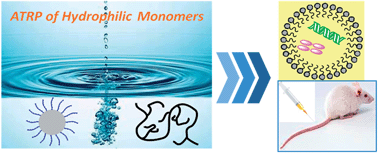a Jiangsu Key Laboratory of Advanced Functional Polymer Design and Application, Department of Polymer Science and Engineering, College of Chemistry, Chemical Engineering and Materials Science, Soochow University, Suzhou, China
Polym. Chem. 2013, 4, 2919-2938.
Atom transfer radical polymerization (ATRP) has become one of the most widely used living radical polymerization techniques for preparation of polymers with pre-designed compositions, topologies and functionalities. Hydrophilic (co)polymers are broadly used in various fields, such as hybrid materials, surface modification and delivery carriers in biomedical areas because of their diverse functionalities and ideal characters, including their non-toxicity, biocompatibility and environmentally friendly nature. Polymerization of hydrophilic monomers by ATRP provides polymers with more colorful structures, as well as novel properties and extends the application scope of hydrophilic polymers due to its facile operation and commercially available catalysts, ligands and initiators of the methodology. This review focuses on ATRP of hydrophilic monomers, as well as its application as detailed in five aspects: (1) basic understanding of the ATRP mechanism and polymerization kinetics of hydrophilic monomers; (2) polymerization media for hydrophilic monomers; (3) topologies of polymers based on hydrophilic monomers; (4) polymerization by combination of ATRP with other techniques, and (5) applications of polymerization of hydrophilic monomers.

链接: //pubs.rsc.org/en/content/articlelanding/2013/py/c3py00122a#!divAbstract